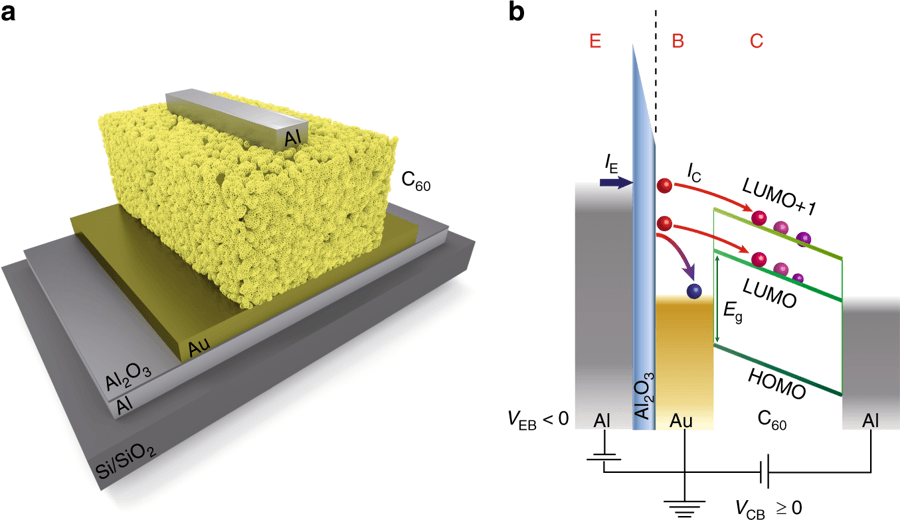May 10 2019
Physicists at the Research Cluster Center for Advancing Electronics Dresden (cfaed) of the TU Dresden, in collaboration with scientists from Belgium, Spain, and Germany, could demonstrate the behavior of electrons upon being injected into organic semiconductor films.
 Device schematics. (a) Schematic cross section of the device. (b) Hot-electron transistor operation. Electrons are injected by applying a negative emitter-base bias, and detected in the molecular semiconductor. These electrons are out of equilibrium with the thermal electrons in the base which cannot be described by a larger temperature. The measurements can be performed either without or with externally applied collector-base bias. (Image credit: TU Dresden)
Device schematics. (a) Schematic cross section of the device. (b) Hot-electron transistor operation. Electrons are injected by applying a negative emitter-base bias, and detected in the molecular semiconductor. These electrons are out of equilibrium with the thermal electrons in the base which cannot be described by a larger temperature. The measurements can be performed either without or with externally applied collector-base bias. (Image credit: TU Dresden)
Experiments and simulations found various transport regimes.
The processes of charge transfer play a key role in each electronic and optoelectronic device. In organic thin-film technology-based devices, charge transfer processes include the addition of the charge carriers through metallic contacts and the charge transport in the organic film itself. Here, the processes of injection at the contacts have gained increasing attention because the contact resistances at the interfaces ought to be reduced for optimum device efficiency. But such internal interfaces are difficult to access and hence not yet understood exactly.
Currently, the team of cfaed research group leader Frank Ortmann (Computational Nanoelectronics Group), in collaboration with scientists from Belgium, Spain, and Germany, has shown in a study that the introduction of electronic transport mechanism into an organic film can be explained by what is called the Marcus hopping model from physical chemistry. Rudolph Arthur Marcus, an American chemist, developed this model. The comparative experimental and theoretical investigations clearly determined the transport regimes predicted in the Marcus theory.
The predictions derived by R.A. Marcus in the context of chemical synthesis in the 1950s, in particular the so-called ‘inverted Marcus regime’, could only be confirmed many decades later by systematic experiments on chemical reactions. For his important theoretical contributions, R.A. Marcus received the Nobel Prize for Chemistry in 1992. Now, the observation of the ‘Inverted Marcus Region’, in which a higher voltage generates a lower current, succeeded for the first time in an organic transistor, in which the injection voltage can be actively controlled.
Frank Ortmann, cfaed Research Group Leader, TU Dresden
Generally, this study gives better insights into electronic and optoelectronic organic devices. The study has been published on May 7th, 2019, in Nature Communications.